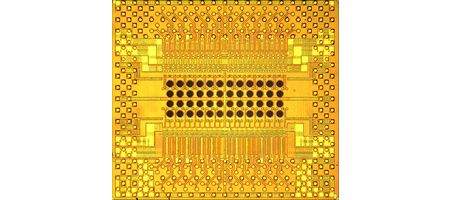IBM scientists have produced a prototype optical chipset that can transfer a whacking terabit of data per second – the equivalent of downloading 500 high definition movies.

Unlikely as it seems, the speed breakthrough was produced by drilling 48 minuscule holes in a standard quarter-inch silicon CMOS chip.
“Reaching the one trillion bit per second mark with the Holey Optochip marks IBM’s latest milestone to develop chip-scale transceivers that can handle the volume of traffic in the era of big data,” says IBM researcher Clint Schow.
“We have been actively pursuing higher levels of integration, power efficiency and performance for all the optical components through packaging and circuit innovations. We aim to improve on the technology for commercialization in the next decade with the collaboration of manufacturing partners.”
The 48 holes in the Holey Optochip allow optical access through the back of the chip to 24 receiver and 24 transmitter channels – producing an ultra-compact, high-performing and power-efficient optical module.
It’s not only capable of record setting data transfer rates, says IBM, it can do this at a very high power efficiency, with the transceiver consuming less than five watts.
Best of all, says the team, the Holey Optochip module is constructed with components that are commercially available today, allowing for economies of scale.
The Holey Optochips are designed for direct coupling to a standard 48-channel multimode fiber array through an efficient microlens optical system that can be assembled with conventional high-volume packaging tools.
“By demonstrating unparalleled levels of performance, the Holey Optochip illustrates that high-speed, low-power interconnects are feasible in the near term and optical is the only transmission medium that can stay ahead of the accelerating global demand for broadband,” says IBM.
“The future of computing will rely heavily on optical chip technology to facilitate the growth of big data and cloud computing and the drive for next-generation data center applications.”






